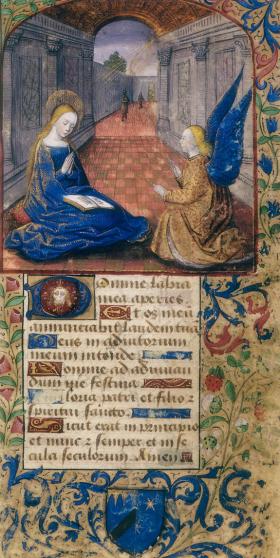A Medieval calendar
Key inquiry question #1
What key beliefs and values emerged and how did they influence societies?
Content summary
The way of life in Medieval Europe (social, cultural, economic and political features) and the roles and relationships of different groups in society (ACDSEH008)
Students:
- describe everyday life of men, women and children in Medieval European society
- identify the roles and relationships of key groups in Medieval Europe society, using a range of sources
Significant developments and/or cultural achievements, such as changing relations between Islam and the West (including the Crusades), architecture, medieval manuscripts and music (ACDSEH050)
Students:
- identify and describe significant developments and/or cultural achievements of Medieval Europe in at least ONE of the following areas: architecture, art, medieval manuscripts, literature and music
Background Notes for teachers
A Book of Hours is a book of prayers for the eight hours of the monastic day. It was lavishly illustrated and very popular during the Medieval Ages. Books of Hours were primarily owned by wealthy, literate people and used to assist them in their daily religious practice by telling them the appropriate prayers and the correct holidays during the year.
Only the wealthy could afford them because the printing press had not yet been invented. Each book was hand-written on parchment (sheepskin) or vellum (calfskin). Some of the colours used in the decorations were produced by crushing gemstones or applying gold or silver leaf.
In Medieval monasteries, twenty-four hour days were divided into eight segments called the ‘Liturgy of the Hours’. It was during these times or ‘hours’ that prayers from the book should be read. A day comprised of: 1. Matins (around midnight); 2. Lauds; 3. Prime; 4. Terce; 5. Sext; 6. Nones; 7. Compline, and finished with 8. Vespers (around 9 pm).
The content of the books typically included prayers, gospel stories, and commemorations of saints and calendars of holy days. They would usually be written in Latin and would be passed down as heirlooms in a family. People took their Books of Hours to bed, and to occasions like baptisms; they often asked the artists to include their own portraits in them. They were personal, precious, treasured objects. Books of Hours provide us with a unique opportunity to experience the private lives of everyday people from Medieval times and the illustrations in each book can tell us important information about daily in Medieval Europe.
This Book of Hours was produced in the workshop of Jean Colombe of Bourges around 1480 AD and contains 12 small double miniature illustrations for the calendar. Each illustration shows the appropriate labours for each month with signs of the zodiac. The subjects of the small miniatures are: January - feasting; February - digging; March - pruning vines; April - going on pilgrimage; May - lovers courting; June - scything; July - reaping; August - sowing; September - gathering acorns; October - treading grapes; November - stoking a fire; December - killing a pig.
Student Activities
A Medieval Manuscript
Students examine a Medieval manuscript and complete activities.

NSW Syllabus for the Australian Curriculum History K-10
A student:
- HT4-3 describes and assesses the motives and actions of past individuals and groups in the context of past societies
- HT4-5 identifies the meaning, purpose and context of historical sources
- HT4-7 identifies and describes different contexts, perspectives and interpretations of the past
Students:
Comprehension: chronology, terms and concepts
- read and understand historical texts
- use historical terms and concepts (ACHHS206, ACHHS149)
Analysis and use of sources
- identify the origin and purpose of primary and secondary sources (ACHHS209, ACHHS152)
- draw conclusions about the usefulness of sources (ACHHS211, ACHHS154)
Perspectives and interpretations
- identify and describe different perspectives of participants in a particular historical context (ACHHS212, ACHHS155)
Empathetic understanding
- interpret history within the context of the actions, attitudes and motives of people in the context of the past (ACHHS212, ACHHS155)
Research
- identify and locate a range of relevant sources, using ICT and other methods (ACHHS208, ACHHS151)
- Continuity and change: some aspects of a society, event or development change over time and others remain the same
- Perspectives: people from the past may have had different views shaped by their different experiences
- Empathetic understanding: the ability to understand another’s point of view, way of life and decisions made in a different period of time or society
Learning across the curriculum
- Information and communication technology capability
- Intercultural understanding
- Literacy
- Civics and citizenship
- Difference and diversity
- Work and enterprise